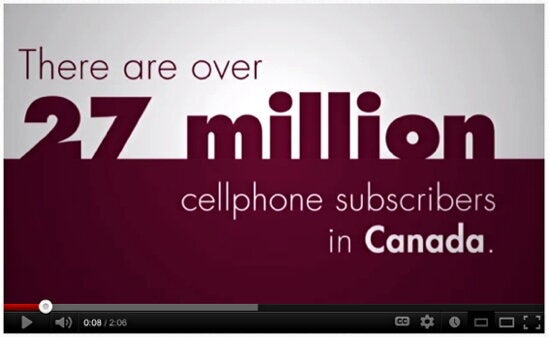

"The Wireless Code is being developed through a public consultation, which includes this online consultation and a public hearing in February 2013." - CRTC, Nov 13, 2012.
Wireless code, great -- online consultation, not so much
Back in the summer of 2010, the CRTC decided to get the public's input online as part of its proceeding on the "obligation to serve." Big mistake.
I wrote a two-parter at the time about that exercise, entitled "The CRTC needs to connect with Canadians, not consult with them." In Part one, I excoriated the Commission for its wrong-headed priorities and poor communication. In Part two, I focused on what happens when a government agency jumps on the social media bandwagon without commitment, follow-through or expertise. I collected detailed YouTube and other stats that showed the social media add-ons were a failure: little traffic, no SNS dialog, zero viral activity. (And social media history is now repeating itself.)

Overview. Today, over two years later, I'm writing this post (in two or maybe three parts) as a follow up to the 2010 posts. I offer them as a caution about a habit that's getting entrenched at the Commission: treating online consultations as a substitute for both educating Canadian consumers and conducting real research (like random-probability surveys on consumer attitudes and behaviours).
These consultations offer a seductive kind of window-dressing, because they make the Commission feel they know what the Canadian public wants, and they make the public feel good about having a forum in which to vent spleen. Unfortunately, online "surveys" are not only unrepresentative, they can also be highly misleading, especially when the response rate is low. Speaking of response rate, let me jump to information I've pulled from the YouTube version of the video that's running on the consultation page.
As of noon Friday, November 23, the YouTube page indicates there's been a grand total of 845 views. It's now 10 days since the launch of the consultation. Worse still, the total four days ago was 768 -- meaning an increase this week of barely 10 per cent. Of course, thousands of other people might have viewed the video on the CRTC site.
Ah, but therein lies the problem: the CRTC ain't telling us. Go to the YouTube page and try clicking on the graph icon to the right of the number of views. Normally, this brings up some very useful stats about how the video has been viewed and by whom, including the rate at which viewing is growing. Not here. What we get is: "Public statistics have been disabled." Moreover, the YouTube page is where social interaction takes place -- except that the comments section reads "Comments are disabled for this video." A question I'd like to ask the consultation manager: why are you hiding participation data in an open public consultation?
To summarize, I see three problems confronting the Commission. First, its use of online consultations is a distraction from evidence-based policymaking. Second, the Commission has failed in its mission to educate Canadians about the digital age. Indeed, it makes claims about the health of our communications industries that are at the least unproven, and at worst, plainly false. Third, our regulator has jumped on the social media bandwagon without a clue as to how to make it worthwhile: social networking is not a spectator sport.
Gobbledygook and half-truths
The current online consultation is being conducted under the banner "Help Develop a Wireless Code." Once again, it shows symptoms of the Commission's long-standing problems in communicating with the public. This time, at least one thing is different. The appointment of Barbara Motzney as Chief Consumer Officer provides some hope that resources will be found to resolve the problems I discuss here. To say nothing of the fact the consumer-oriented agenda established by Chairman Blais would benefit greatly from a better understanding of how to talk to the people he wishes to empower.
When it's not using the jargon of the priesthood, the CRTC talks to consumers in an over-simplified and patronizing way. Worse still, it doesn't bother to explain anything outside of its decisions and press releases. And all this trouble is compounded by the appallingly bad architecture of the Commission's website, which inflicts a double-whammy on visitors seeking to understand the issues. On one hand, its site is chock full of references for which it doesn't provide a pointer. On the other hand, when it does guide you to some kind of answer, the material is incomprehensible to anyone but experts. Here's what I mean...
In a decision issued earlier this month (Telecom Decision CRTC 2012-622), there's a reference to background materials in the public record:
"The public record of this proceeding is available on the Commission's website at www.crtc.gc.ca under 'Public Proceedings' or by using the file number provided above" (para 6).

The "Public Proceedings" tab on the CRTC homepage has four links under it, one of which is "Telecom proceedings open for comment." Is that what the visitor needs if she's looking to read the public file? Nope. The page you're taken to makes no reference to CRTC 2012-622. What about the other option: clicking on the file number: 8622-C6-201208471? That takes you to a long page with tabular material that scrolls through dozens of proceedings. Fine, how about Command-F? Aha, there is a cell in this interminable table that seems to be what we want. Its serial number, OTOH, is 2012-0847-1, which has nothing to do with the proceeding serial number (2012-622). Except the last nine digits are the same as the file number. Etc, etc.
Holy shit, man, would it be too much to ask the staff to provide a lousy permalink to take us directly, in one click, to what we were looking for? Berners-Lee and Cailliau launched the first hyperlinked public Web page 21 years ago; and permalinks have been in widespread use for over a decade. (And while we're at it, how about using canonical URLs, instead of mysterious strings of numbers known only to the staff, so we can see what our destination is going to be from the URL.)
Now the flip side of the problem: from too little information to way too much. In my post on the 2010 online consultation, I wondered aloud whether the Commission thought it was being helpful in its FAQ by directing visitors to two telecom notices as background reading, the better to understand this thing they call the "obligation to serve." Imagine regular folks landing on CRTC 2010-43 and getting warmed up with this intro:
"This proceeding will [...] re-examine the local competition and wireless number portability frameworks in the territories of the small incumbent local exchange carriers. In addition, the Commission will re-examine the appropriateness of the existing forbearance framework for mobile wireless data services."
Now that we've flogged that moribund horse into oblivion, let's turn to a related piece of the puzzle - speaking in half-truths. As the consultation homepage indicates, the Commission has discovered the wonderful world of Web video. Here's a frame grab from the 8-second mark...

The clip comes at you like an infomercial. Fast cutting and bouncy graphics are backed by a breezy sound track (one of my kids, a trained musician, describes it as "funky elevator jazz"). The first piece of content takes the form of a Q&A. The video asks, "Did you know...?" And the answer as above: "There are over 27 million cellphone subscribers in Canada."
It's clear from the way this factoid is conveyed that we're meant to share in a sense of excitement, especially since the video continues with the revelation that we send 234 million texts every day! Wow, that many? Yes, these might be big numbers -- except for life's all-important question: compared to what?
The 27-million figure is misleading for two reasons. First, there's no comparative benchmark.
Second, "cellphones" covers both feature phones and smartphones. In case you hadn't heard, a mobile broadband tidal wave is roaring towards us, and only broadband-capable phones will be up to coping with it. According to projections from Cisco's VNI forecast for 2011-2016, wired devices accounted for 55 per cent of global IP traffic in 2011; by 2016, that proportion will plunge to 39 per cent, meaning wireless devices will carry 61 per cent of all traffic. Put another way, mobile IP traffic will grow over the forecast period at a CAGR of 78 per cent, representing an 18-fold increase from 2011 to 2016. That puts feature phones on the wrong side of the next incarnation of the digital divide.
In the Part 2, we'll look at how key penetration numbers and other data from the FCC and OECD suggest the CRTC is misrepresenting the anti-competitive nature of Canada's wireless market...